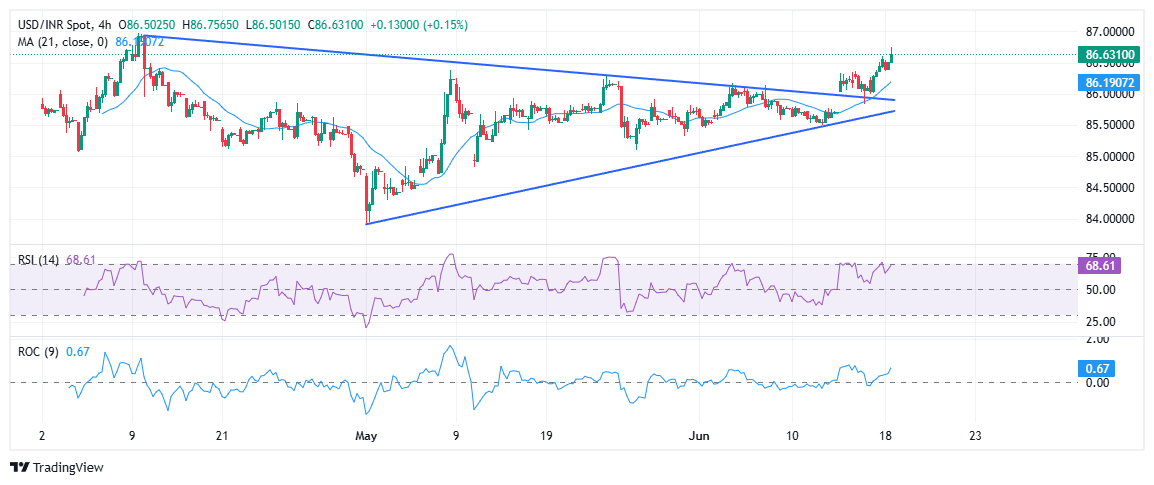
- The USD/INR extends its gains, hovering near a two-month high around 86.63, supported by safe-haven flows into the US Dollar.
- Iran-Israel conflict escalation and rising Crude Oil prices dampen emerging market currencies, adding pressure on the Rupee.
- Traders eye the Federal Reserve’s monetary policy decision and updated projections for fresh direction, while the RBI works to align domestic rates.
The Indian Rupee (INR) remains on the back foot against the US Dollar (USD) on Wednesday, marking its second consecutive day of weakness, despite a relatively subdued Greenback ahead of the key Federal Reserve’s interest rate decision. Higher Crude Oil prices and deepening tensions between Iran and Israel continue to cloud sentiment, keeping emerging market currencies, such as the Rupee, under pressure.
USD/INR is trading higher, holding near the two-month peak it touched earlier on Wednesday at 86.75. At the time of writing, the pair hovers around 86.63.
The conflict between Iran and Israel has now entered its sixth day, showing no signs of de-escalation as both sides trade heavy strikes. Israeli forces have continued hitting military and suspected nuclear sites deep inside Iran, while Tehran has fired waves of missiles and drones in retaliation. The fighting has rattled daily life in the Iranian capital, where reports of casualties are rising, shops and markets have shut down, and fuel shortages are causing long lines at gas stations. Meanwhile, global markets are jittery as speculation grows that the United States (US) might step in if the conflict spirals out of control.
Market Movers: INR pressured by geopolitical risks, RBI measures, and Fed policy cues
- Heightened tensions in the West Asia region have revived demand for the US Dollar, driving the US Dollar Index (DXY) higher on Tuesday as traders favour safe-haven assets. This risk-off mood has triggered capital flight from emerging economies, weighing further on the Indian Rupee. With the Greenback gaining broadly against major peers, the Rupee has struggled to find support, particularly with no strong domestic drivers to offset the external drag.
- Despite external headwinds, the Rupee has held relatively stable, broadly mirroring global currency trends. A recent report by the Bank of Baroda (BoB) highlighted that India’s healthy foreign exchange reserves continue to offer a solid cushion against potential bouts of volatility. While lingering global uncertainties and the expiration of current US tariff exemptions could sway market sentiment, the BoB report noted that the Rupee is likely to stay within its anticipated band if prevailing conditions hold steady. “We expect the INR to trade in the range of 85.25–86.25 against the USD in the near term. Risks persist if geopolitical tensions escalate further,” the report noted.
- In an effort to fine-tune its monetary transmission, the Reserve Bank of India (RBI) is gathering input from market players to better align the overnight call money rate with its key repo rate. The call rate has persistently stayed lower than the policy rate thanks to surplus cash in the banking system. While this helps banks lend cheaply, too wide a gap can drive excessive credit growth and lift inflation risks. Although inflation remains under control for now, experts warn that a mix of geopolitical uncertainty and cheap funds could prompt the RBI to reconsider its inflation targets down the road.
- Despite these currency challenges, India’s macro picture remains robust. Ratings agency ICRA forecasts India’s real Gross Domestic Product (GDP) growth to exceed 6.5 % in FY‑26 and Gross Value Added (GVA) to surpass 6.3 %, while Consumer Price Index (CPI) inflation is projected around 4.2 %.
- Iran’s Supreme Leader, Ayatollah Ali Khamenei, issued a stark warning at dawn, declaring on social media that “the battle begins,” signaling no intention to back down. Just hours earlier, US President Donald Trump called Khamenei an “easy target” and warned that America’s patience is wearing thin, demanding Iran’s “unconditional surrender.” According to reports, Trump is weighing military options, including strikes on Iran’s nuclear facilities, as he grows more skeptical of a purely diplomatic resolution. While sources say he hasn’t ruled out talks entirely, any deal would likely hinge on significant Iranian concessions.
- The US Dollar Index (DXY) is trading slightly lower on Wednesday, hovering around 98.67 as traders remain on the sidelines ahead of the Federal Reserve’s (Fed) interest rate decision due later in the day. On Tuesday, the Greenback had gained about 0.70% on the back of safe-haven flows, despite weaker-than-expected retail sales data, as investors sought shelter from rising geopolitical risks.
- The Fed is widely anticipated to hold the benchmark interest rate steady at the 4.25%–4.50% range as policymakers remain cautious amid fresh uncertainty from President Trump’s new tariffs and policy changes. Traders will look to the updated economic projections for clues on how the central bank sees growth, inflation, and the future path of interest rates evolving.
USD/INR Technical Outlook: Bullish breakout eyes 87.00 as momentum stays strong

The USD/INR pair has staged a clear breakout above a multi-week symmetrical triangle chart pattern on the 4-hour chart, signalling fresh bullish momentum. The breakout is supported by the 21-period Moving Average (MA), which has turned higher and now sits near 86.19, acting as dynamic support.
The Relative Strength Index (RSI) hovers around 68.61, approaching overbought territory but not flashing a reversal signal yet, indicating that the pair could extend gains before any meaningful pullback. Meanwhile, the Rate of Change (ROC) remains slightly positive, reinforcing the case for continued upside momentum.
If the pair sustains above the 86.50–86.60 zone, the next immediate resistance is seen near 87.00, a psychologically significant round figure. On the flip side, a drop below the breakout point and the 21-period MA could expose the pair to a retest of support around 86.20 and then the previous consolidation base near 85.90.
Overall, the technical picture favours USD/INR bulls in the near term, with a clear bias to buy on dips as long as the price holds above the triangle breakout and the short-term moving average.
RBI FAQs
The role of the Reserve Bank of India (RBI), in its own words, is “..to maintain price stability while keeping in mind the objective of growth.” This involves maintaining the inflation rate at a stable 4% level primarily using the tool of interest rates. The RBI also maintains the exchange rate at a level that will not cause excess volatility and problems for exporters and importers, since India’s economy is heavily reliant on foreign trade, especially Oil.
The RBI formally meets at six bi-monthly meetings a year to discuss its monetary policy and, if necessary, adjust interest rates. When inflation is too high (above its 4% target), the RBI will normally raise interest rates to deter borrowing and spending, which can support the Rupee (INR). If inflation falls too far below target, the RBI might cut rates to encourage more lending, which can be negative for INR.
Due to the importance of trade to the economy, the Reserve Bank of India (RBI) actively intervenes in FX markets to maintain the exchange rate within a limited range. It does this to ensure Indian importers and exporters are not exposed to unnecessary currency risk during periods of FX volatility. The RBI buys and sells Rupees in the spot market at key levels, and uses derivatives to hedge its positions.
Information on these pages contains forward-looking statements that involve risks and uncertainties. Markets and instruments profiled on this page are for informational purposes only and should not in any way come across as a recommendation to buy or sell in these assets. You should do your own thorough research before making any investment decisions. FXStreet does not in any way guarantee that this information is free from mistakes, errors, or material misstatements. It also does not guarantee that this information is of a timely nature. Investing in Open Markets involves a great deal of risk, including the loss of all or a portion of your investment, as well as emotional distress. All risks, losses and costs associated with investing, including total loss of principal, are your responsibility. The views and opinions expressed in this article are those of the authors and do not necessarily reflect the official policy or position of FXStreet nor its advertisers. The author will not be held responsible for information that is found at the end of links posted on this page.
If not otherwise explicitly mentioned in the body of the article, at the time of writing, the author has no position in any stock mentioned in this article and no business relationship with any company mentioned. The author has not received compensation for writing this article, other than from FXStreet.
FXStreet and the author do not provide personalized recommendations. The author makes no representations as to the accuracy, completeness, or suitability of this information. FXStreet and the author will not be liable for any errors, omissions or any losses, injuries or damages arising from this information and its display or use. Errors and omissions excepted.
The author and FXStreet are not registered investment advisors and nothing in this article is intended to be investment advice.








